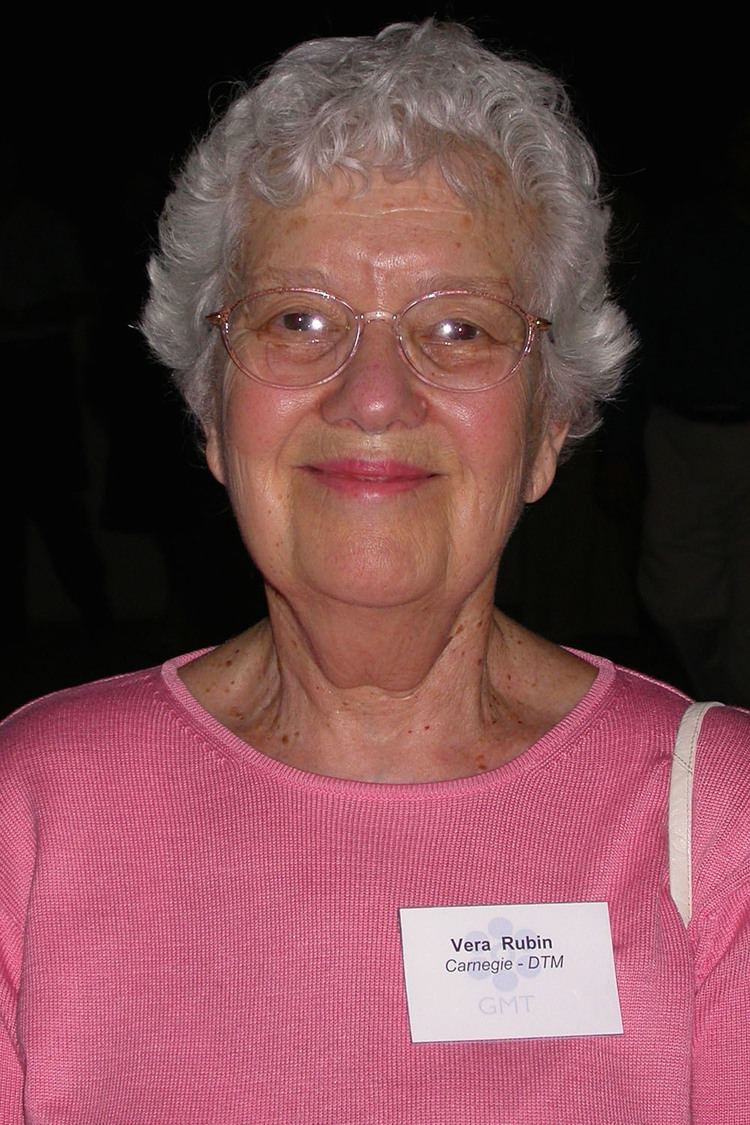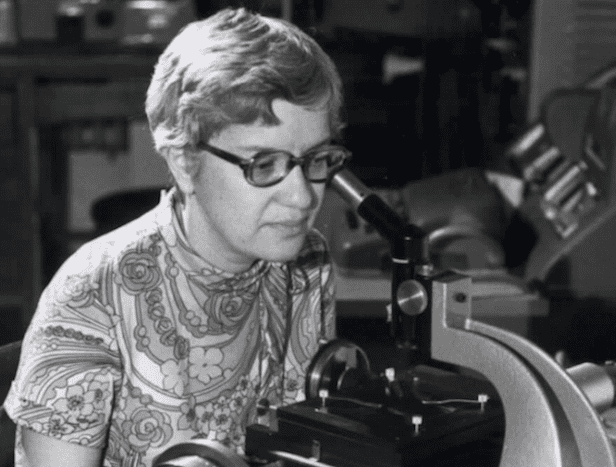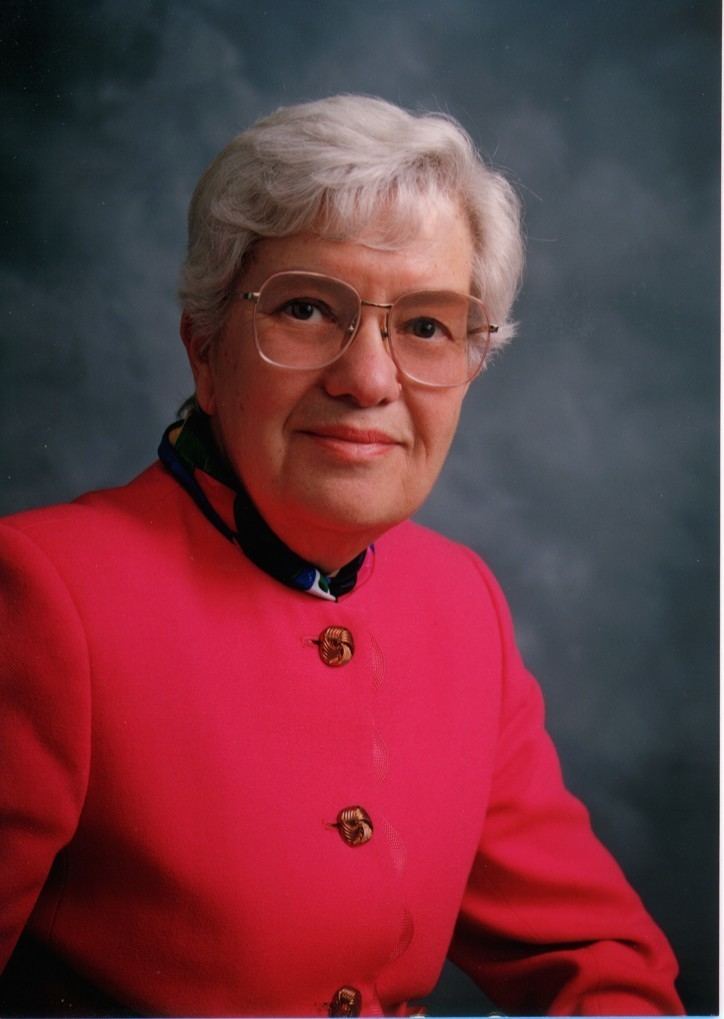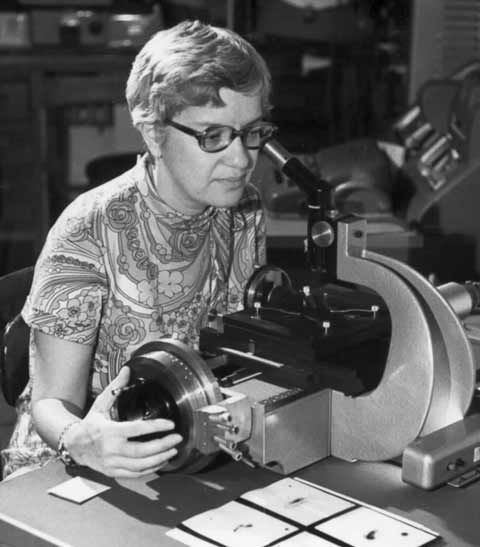Citizenship American Thesis (1954) Role Astronomer | Nationality American Name Vera Rubin | |
 | ||
Notable awards | ||
Astronomy cast 357 vera rubin
Vera (Cooper) Rubin (born July 23, 1928) is an American astronomer who pioneered work on galaxy rotation rates. She uncovered the discrepancy between the predicted angular motion of galaxies and the observed motion, by studying galactic rotation curves. This phenomenon became known as the galaxy rotation problem.
Contents
- Astronomy cast 357 vera rubin
- Vera rubin
- Background and education
- Scientific work
- Galaxy rotation problem
- Dark matter
- Awards and honors
- Named after her
- Personal
- Religious views
- Articles
- Books
- In popular culture
- References

Vera rubin
Background and education

Rubin was born in Philadelphia and lived in Washington, D.C. when she was 10 years old. It was in Washington, D.C. that she started to develop an interest in astronomy. Vera Rubin's father, Philip Cooper, was an electrical engineer, born in Vilnius, Lithuania as Pesach Kobchefski. Her mother, Rose Applebaum, originally came from Bessarabia, and worked for Bell Telephone Company calculating mileage for telephone lines. Rubin has an older sister named Ruth Cooper Burg, who was an administrative judge in the United States Department of Defense. Rubin earned her BA degree at Vassar College and attempted to enroll at Princeton but never received their graduate catalog, as women there were not allowed in the graduate astronomy program until 1975.

She instead enrolled for her Master's degree at Cornell University, where she studied physics under Philip Morrison, Richard Feynman, and Hans Bethe. She completed her study in 1951, during which she made one of the first observations of deviations from the Hubble flow in the motions of galaxies. She argued that galaxies might be rotating around unknown centers, rather than simply moving outwards, as suggested by the Big Bang theory at that time. The presentation of these ideas was not well received. Rubin’s doctoral work at Georgetown University was conducted under advisor George Gamow. Her PhD thesis upon graduation in 1954 concluded that galaxies clumped together, rather than being randomly distributed through the universe. The idea that clusters of galaxies existed was not pursued seriously by others until two decades later.

Upon received her Ph.D in 1954 at Georgetown University, Rubin continued to work on the faculty for another eleven years while raising her children. After her time at Georgetown, Rubin joined the Department of Terrestrial Magnetism (DTM) where she met her long time friend, Kent Ford. Five years after joining the DTM, Rubin and Ford began examining the rotation of neighboring galaxies, the Andromeda Galaxy in particular. Her discoveries in the field of Astronomy has gathered great acclaim heralding several awards including the Gold Medal of London's Royal Astronomical Society making her the second woman to receive the award along with Caroline Herschel.
Aside from her astronomical achievements, Vera Rubin has also been an active and outspoken member in encouraging women to pursue the sciences. During her time at Carnegie, Rubin became the first women to legally observe from the Palomer telescope in San Diego, blazing the path of equality in the tiny observatory. Later in her career, the National Academy of Sciences (NAS) elected her as the second woman ever to join the academy. Rubin was active in pointing out the various discrepancies in gender regarding the reviewers of scientific studies. In the past Rubin along with Margaret Burbidge have advocated for the further involvement of women in groups such as the National Academy of Sciences.
Scientific work
After her graduation, Rubin taught at Montgomery County Junior College, and also worked at Georgetown University as a research assistant, and in 1962 became an assistant professor there. Also in 1965, she became the first woman allowed to use the instruments at the Palomar Observatory. Prior to this, women had not been authorized to access the facilities. In 1965 she also secured a position at the Department of Terrestrial Magnetism at the Carnegie Institution of Washington and has worked there as an astronomer since that time. Rubin is currently a Senior Fellow at the DTM, and her work area is described as "Galactic and extragalactic dynamics; large-scale structure and dynamics of the universe." Since 1978, she has researched and analyzed over 200 galaxies.
Galaxy rotation problem
Rubin began work which was close to the topic of her previously controversial thesis regarding galaxy clusters, with instrument maker Kent Ford, making hundreds of observations. The Rubin–Ford effect is named after them, and has been the subject of intense discussion ever since it was reported. It describes the motion of the Milky Way relative to a sample of galaxies at distances of about 150 to 300 Mly, and suggests that it is different from the Milky Way's motion relative to the cosmic microwave background radiation.
Wishing to avoid controversy, Rubin moved her area of research to the study of rotation curves of galaxies, commencing with the Andromeda Galaxy. She pioneered work on galaxy rotation rates, and uncovered the discrepancy between the predicted angular motion of galaxies and the observed motion, by studying galaxy rotation curves. Galaxies are rotating so fast that they would fly apart, if the gravity of their constituent stars was all that was holding them together. But they are not flying apart, and therefore, a huge amount of unseen mass must be holding them together. This phenomenon became known as the galaxy rotation problem. Her calculations showed that galaxies must contain at least ten times as much dark mass as can be accounted for by the visible stars. Attempts to explain the galaxy rotation problem led to the theory of dark matter.
Dark matter
In the 1970s Rubin obtained the strongest evidence up to that time for the existence of dark matter. The nature of dark matter is as yet unknown, but its presence is crucial to understanding the future of the universe.
The existence of dark matter jointly explains galaxy rotation curves, the motion of galaxies within galaxy clusters, patterns of gravitational lensing, and the distribution of mass in systems such as the Bullet Cluster. Alternative MOND (Modified Newtonian Dynamics) models for galaxy rotation curves have been excluded. Rubin has expressed disappointment about this result, stating "If I could have my pick, I would like to learn that Newton's laws must be modified in order to correctly describe gravitational interactions at large distances. That's more appealing than a universe filled with a new kind of sub-nuclear particle."
Awards and honors
As of 9 June 2013, Rubin has co-authored 114 peer reviewed research papers. She also served on the board of trustees for Science Service, now known as Society for Science & the Public, from 2002–2008.
Named after her
Personal
Rubin has been married since 1948 to Robert Rubin, whom she met while he was a fellow graduate student at Cornell University majoring in physical chemistry. All four of her children have earned PhDs in the natural sciences or mathematics: David (1950), PhD geology, a geologist with the US Geological Survey; Judith Young (1952), PhD cosmic-ray physics, an astronomer at the University of Massachusetts; Karl (1956), PhD mathematics, a mathematician at the University of California at Irvine; and Allan (1960), PhD geology, a geologist at Princeton University.
Motivated by her own battle to gain credibility as a woman astronomer, Rubin continues to encourage young girls to pursue their dreams of investigating the universe. Overcoming discouraging comments on her choice of study was a constant challenge, but she persevered, supported by her father and, later, her husband and family. In addition to astronomy, Rubin has been a force for greater recognition of women in the sciences. She has advocated for more women in the National Academy of Sciences (NAS), on review panels, and in academic searches. She says that she has fought with the NAS, but she continues to be dissatisfied with the number of women who are elected each year. She states that it is the saddest part of her life and says, "Thirty years ago, I thought everything was possible."
Of her potential legacy, Rubin remarked : “Fame is fleeting, my numbers mean more to me than my name. If astronomers are still using my data years from now, that’s my greatest compliment.”
Religious views
Rubin is an observant Jew, and sees no conflict between science and religion. In an interview, she stated: "In my own life, my science and my religion are separate. I'm Jewish, and so religion to me is a kind of moral code and a kind of history. I try to do my science in a moral way, and, I believe that, ideally, science should be looked upon as something that helps us understand our role in the universe."
